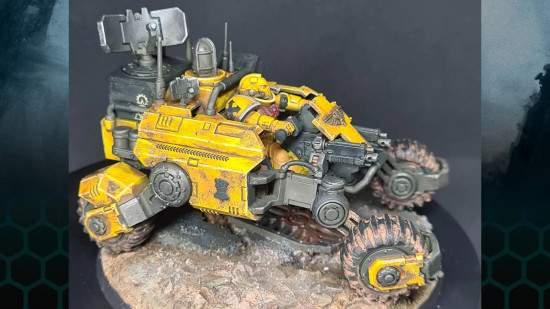Few Warhammer 40,000 vehicles are as dopey as the Invader ATV, a Space Marines recon support vehicle with no ground clearance, no suspension, and a gunner positioned to deafen the driver. We asked Imperial Fists superfan Phalanx_Minis how he converted his squadron of Invaders to fix this most questionable of vehicles.
Phalanx_Minis, aka James in real life, has been collecting Imperial Fists Space Marines “for about two years”, and now has “roughly half” of the entire Space Marines Chapter built. His end goal is to make “the whole Chapter including auxiliary support”. Despite this ambitious goal, he couldn’t initially bring himself to consider the Invader ATV.
“It really didn’t look like it could handle a cobblestone road, let alone a hostile landscape”, James says. Many conversions of the notoriously goofy kit are floating around the internet, but these either “seemed too complex” to convert, or like they wouldn’t fit into the style he’d established in his Warhammer 40k collection – you can check out his other minis on his Instagram.
All it took was for an Invader kit to land in James’ lap before he “grew sort of fond of it”, and began to percolate ideas. “I really didn’t like the idea of a gunner so close to the driver’s head so thought about what else I could use this for”, he says.
He considered both a supply vehicle “with loads of crates”, and “an apothecary ATV with a wounded marine strapped to the rear”, but “for lack of available parts settled on a sort of Reconnaissance ATV” with a radar assembly.
The radar conversion proved “surprisingly straightforward”, and involved “plasticard to build up the box and cutting to size a few pieces from the Impulsor kit”. But “the main point of bringing these models to life” was to fix the suspension. That felt like “a bit of a gamble” to James: “I’d never done it before and it involved a bit of hacking with a good sharp hobby knife”.
James cut away the rear wheel assembly and its connecting shaft from the chassis, following the curve of the cylinder they connect to. “Once it’s been removed you can pretty much choose whichever angle you want” he says, adding “if you’ve done it right, the end of the shaft should be nicely curved” so it slides around the cylinder easily.
He recommends sprue-goo – a concoction made by dissolving spare sprue plastic in polystyrene-cement – to smooth the connection.
The front wheels were trickier. In his first model he “cut off the front suspension entirely” so he could adjust the rotation of the wheels, but “what I struggled with was finding the right piece to give some lift”.
Without that, “the wheels would be too low in a sort of drag racer style”. This stumped him for a while, James admits, saying: “the radar ATV had been sitting around in the drag racer pose for months before I figured out how I might lift the front”.
James found just the piece he was looking for by “rummaging in my bits box”. Part of the Grey Knights Dreadknight kit, “a sort of shaft with two circular end pieces” that normally connects to the Dreadknight’s shoulders and arms, “fit so well attaching the wheels to the front suspension that I ended up getting two more ATVs just to repeat the conversion”.
He’s yet to field them in battle, and he expects them to get “blown up very quickly” when they face off against other Warhammer 40k factions, but James is justifiably chuffed. As for what’s next, he has “lots and lots of Gravis armor to do” to finish up his Imperial Fists 3rd Company.
We’ve seen a spate of great conversions and custom builds recently – make sure you check out the Danny DeVito cybercherub, and the 8” tall papercraft Dreadnought!
Source: Wargamer




